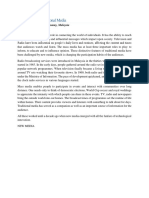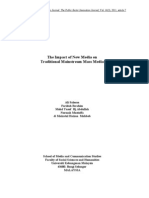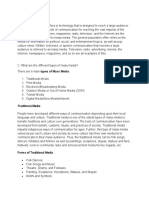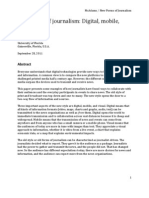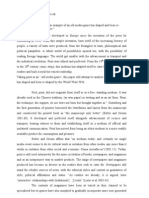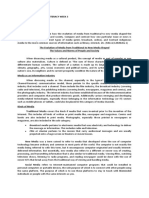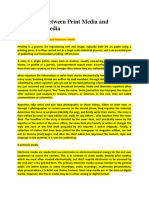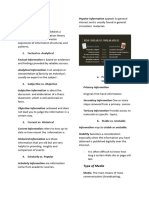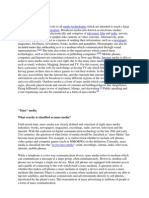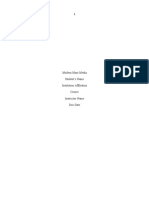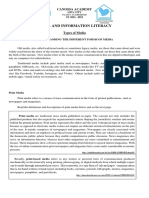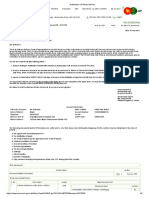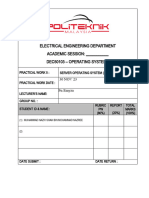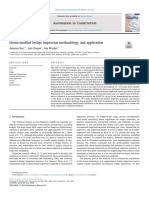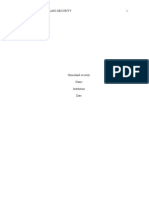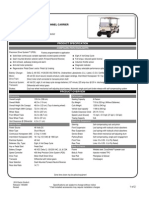JCM1200
MEDIA PRACTICES IN
CONTEXT
2013/2014
MODULE LEADER:
Naval Kishore
Essay question: New media
technologies have made traditional, mass
media forms of information production
and distribution irrelevant. Discuss in
relation to the impact of the Internet on
print media and journalistic practice.
Omowunmi
Gbadamosi
MISIS
NO:M00386388
�Media has evolved from when the first printed
pages came into existence more than 500
years ago. Media has delivered a lot of
information and entertainment since then. In
the 1900's radios, news letters, magazines,
televisions didn't exist and newspapers which
is one of the oldest form of traditional media
monopolized the whole media market.
However media today has become a
multifaceted sector and has become an
important part of ones life. Through the use of
the Internet for example, one can now
communicate with anyone on earth almost
�instantly (Education, Foundation, 2012). New
media technologies have challenged the
specific features of traditional media which
are to influence the opinion of the audience, to
inform the audience and to educate the
audience. New media technologies such as the
internet has provided useful services to its
users such as the electronic mail service
popularly known as e-mail service, world wide
web which is "made up of a large number of
interlinked documents"( James, 2010), news
groups, file transfer, remote access and voice
and video over IP (James, 2010). This essay
will discuss whether new media technologies
have made traditional mass media forms of
information production and distribution
irrelevant, with a special focus on the impact
of the Internet on print media and journalistic
practice. The first section would discuss the
general impact of new media forms on
traditional forms and if it has made these
traditional forms irrelevant, the second section
will discuss the debate on the impact of the
internet on journalistic practice and the third
section will discuss the debate on the impact
of the Internet on print media This essay will
conclude by observing that new media
technologies have almost taken over
traditional forms however not completely.
In this section, an overview on the general
�impact of new media echnology on traditional
forms of media distribution and production, for
a deeper perception into the general topic
surrounding the debate. Conventional forms of
media have been challenged by the advent
of new forms of media. According to
Nagasvare and Krishnasamy traditional media
includes newspapers, radio and television
(Nagasvare and Krishnasamy, 2009). The most
recent software that controls a cyber culture
with concurrent digital data and computer
technology is referred to as new media. CD,
DVDs, computer multimedia, ROM games,
websites and internet are examples of new
media technologies that are interactive,
squeezable, net workable, digital, impartial
and dense (Nagasvare and Krishnasamy,
2009). Digital media technologies like online
journalism, digital photojournalism, social
media and blogging make it easier for people
to follow up on updates of news stories on the
internet for example viewers could get the
updates on the bombing and captivity that
occured in the Kenya shopping mall by
terrorist groups as the situation was currently
happening and changing hourly. Nevertheless,
digital journalism raises questions in new
media on how and what stories should be
published and also what stories and images
provided by the people should be published.
The large amount of enterprise and technology
�for developing good quality service is the
reason the current time is referred to as the
'golden age for new media'. There is no
thought of commitment of any type to only
one news avenue because people can access
as much substance and information the worlds
greatest journalists have from the Internet.
People no longer have to wait for a published
newspaper or magazine or for a show or news
broadcasting to come on television (Nagasvare
and Krishnasamy, 2009). This enables the
younger generation to receive information
anywhere and anytime as they are attracted to
the fast rate of information through mobile
phones and computers. New media
technologies like digital broadcasting and the
internet (Nagasvare and Krishnasamy, 2009)
have affected traditional forms of media
distribution and production in different ways
which makes traditional forms of media
irrelevant. New media has made people on the
receiving end of mass communication with a
one way nature have increasingly become
distributors and producers of information. It
has been said that it is now highly difficult to
recognise between people who digest and
produce information (Creeber and Martin,
2009; Bennett, 2003). Further more Journalistic
professionalism faces some difficulties and
raises questions on who should be seen as a
reliable journalist and who is to be addressed
�as an electronic journalist (Kruckeberg, 1995,
p. 80). Thus these new media technologies
such as the Internet, raises awareness on the
freedom given to non-professionals who
believe they are journalist to write articles and
publish news on the internet because they
provide people with information as journalistic
expertise do. However, Journalist in Africa
believe the internet is not a disadvantage for
journalistic practice, they argue that it helps
news gathering around the world faster and
easier, in addition to this they also find its
usefulness attractive as the cost of world news
gathering from the internet is much cheaper in
comparison to the high cost of subscription to
utmost western news avenues through wired
service subscription (Obijiofor, 2001). New
media technologies serves as a point of mass
information distribution and communication, it
gives journalists in Africa the freedom to
access a huge range of news sources including
radio and television sources available on the
internet. Therefore new media technologies is
more appealing as it can enable information
distribution and production at once and it
being a cheaper option (Banerjee, 2008). This
supports the statement that new media
technologies are making conventional forms of
information production and distribution
irrelevant because they lack the advantages of
new media technologies. Also Journalists in
�Singapore also believe new media
technologies has benefited them as it has lead
to the increase in focus on constructive news
and information in South-eastern Asia where
countries have very bad representation from
western news avenues. An example will be
when foreign western news avenues speak
about South-eastern Asia like Malaysia, their
main focus is on child abuse, drugs, poverty
and other destructive news. The Malaysian
news avenues decided not to follow the steps
of the western avenues but instead they use
the Internet to provide information to the
world on beautiful things Malaysia has to offer
such as tourism and culture. However, when a
study in Malaysia compared the credibility of
information on the television and the Internet,
it showed that Malaysians believe the more
credible form of information production and
distribution is the television and not new
media technologies like the internet (Banerjee,
2008). Thus, it can be argued that some
Malaysian people prefer conventional types of
information production and distribution. As a
result of this one can say that traditional forms
of production and distribution has been
rendered by new media technologies for
example selling of newspapers has been
rendered because the consumers no longer
need these traditional forms and can now do it
themselves. The new demand for more
�interactive and participative content which is
mostly produced by the people has resulted to
traditional mass media outlets struggling to
upgrade to changing standards (Bennett,
2003). The requirement of low investments
and decentralization of new media
technologies implies that the new media
technologies are making traditional forms of
production of information irrelevant because
this makes new media technologies
increasingly attractive for the use of
information production and distribution rather
than the more costly and expensive traditional
forms of information distribution and
production. However, Journalist in Africa
This section will give an overview of the
general impact of new media technologies on
traditional forms of media in relation to print
media. "Print media are lightweight, portable,
disposable publications printed on paper and
circulated as physical copies in forms we call
books, newspapers, magazines and
newsletters" (Curtis, 2011). Print media
consists of entertaining and highly informative
content which is used to learn about the world
and what is happening in it. The way people in
modern society learn, act and think has been
shaped by print media (Willborn, 2011). New
media technologies such as Internet,
broadcast and electronic media are some of
�the main competitors of print media today. As
a result of this magazines, newspapers, books,
and newsletters companies have increasingly
begin to publish digital electronic editions
available on the internet. According to PrezPena, as the internet is increasingly growing
and is obtaining billion of users, conventional
print media for example newspapers have
suffered massive declines in circulation (PrezPea, 2008). There has been a huge amount of
arguments that newspapers and also
magazines have lost a large number of readers
to new media technologies such as the
internet and world wide web. The presence of
new media and the Internet in particular, has
posed a challenge to conventional media,
especially the printed newspaper (Domingo &
Heinonen, 2008). Today, one no longer has to
wait for the distribution of newspapers the
following morning or to receive television
bulletin when the internet is updated twenty
four hours with views, endless amount of
information and the latest news that also gives
the opportunity for viewers to comment, share
ideas and opinions to make it known to others.
The Internet is used to search for knowledge
and information by billions of people around
the world today. The Internet is being used as
a new channel for propagating news and
information to information finders around the
world instantaneously. The Internet has lead to
�a big change of readership habits as print
media consumers now seek news and
information for free on the internet. According
to a study by OECD (organization for economic
co-operation and development), twenty out of
thirty OECD countries are facing a decline in
newspaper readership "It found that UK
circulation has fallen by 25% between 200709, second only to the US, where the decline
was 30%. Greece (20%), Italy (18%) and
Canada (17%) have also seen significant falls"
(Robinson, 2010). Studies on survey
respondents show that there has been a
decline in their demand of print media
because they started using the Internet
(Fernandes, 2009). Since print media lost
readership to new media technologies such as
the Internet, there has been and increase in
the lose of jobs in print media. According to
the Newyork times, American newspaper the
Post-Intelligencer cut the number of staff from
one hundred and sixty five to only twenty
workers (Fernandes, 2009). The Internet
provides a well detailed context on news and
information because videos, image galleries,
and links to articles can be easily included on
the internet. Newspapers have limited space
for printing but space on the internet is
unlimited which allows to have a very well
detailed article, story or news which can be
very easily located (Williams & Nicholas, 1998,
�p. 255). This is therefore a negative impact the
Internet has on print media. Although this may
not mean print media is irrelevant cause of the
Internet. However some people argue that the
internet has positive impacts on print media as
it compliments print media that is, it provides
a base for traditional print media to have an
online presence, therefore many mainstream
news outlets are adopting the free publishing
characteristics to their very own online
versions on the internet. Some argue that the
Internet compliments print media is a posaitive
result for print media because it creates an
online platform which gives presence to
traditional print media. However, as a result of
copyright concern, the reproduction of a print
article online without the permission of the
author, even if the originating newspaper is
the reproducer, is a violation of the authors
copyright. Thus, while the Internet provides
newspapers with limitless space for their
content, the content they are able to upload
can be limited, which can lead to a lack of
coverage on certain topics (Williams Nicholas,
1998, p. 260). This could therefore lead to the
lose of online newspapers acquiring
consumers and advertisement opportunities
which would lead to the lose of more profit
compared to if the company remain only print
media (Williams Nicholas, 1998). Thus this is
therefore a negative impact the Internet has
�on print media but this may not mean the
internet is making print media irrelevant and
useless.
Print media version of information may
become irrelevant because the availability of
print media online could have a negative
impact on hard copies of magazines and
newspapers because most consumers may
choose the companies online version rather
than its print version (Williams and Nicholas,
1998). It has been made aware that some
newspapers find themselves having to choose
between providing existing staff the extra work
load of working on online content or hiring new
staff. This shows that the Internet may be
negatively disrupting print media on finance
troubles and staffing. This does not indicate
that print media is becoming irrelevant
because of the Internet although this is a
negative effect of the Internet on print media.
Further more, Some have argued that the
Internet does not affect the conventional core
competences of magazines. Due to the level of
customer involvement, the expense and the
period of consumption it is said that
magazines are the communication that is most
similar to the Internet, thus there is direct
competition between magazines and the
Internet (Ellonen, 2006). This implies that the
fact that magazines can compete with the
Internet, they are not irrelevant. Some people
�have argued that the Internet has not
significantly affected the demand for print
media, and sudden replacement of
conventional printing and publishing but
instead a gradual evolution towards new IT
(Hetemkis, 1999, p. 4-5).
The biggest current newspaper (the punch) in
a developing third world country as Nigeria
with the population of 140 people, the
circulation of the punch is lower than 100,000
copies per day. This is as a result of the high
number of uneducated Nigerians which shows
that there are other negative factors to be
considered other than the internet that affect
print media in third world countries. This
shows that the low sales of the punch
newspaper has nothing to do with the internet
(Nairaland, 2009). People have argued that the
Internet has not remarkably affected the
request for print media "sudden replacement
of conventional printing and publishing" but
rather a "gradual evolution towards new
IT"(Hetemkis, 1999, p. 4-5). In this
component one can see that although the
Internet has had various negative effects on
print media, it however has not made print
media irrelevant.
This essay has talked about the effects of
new media technologies on traditional forms of
information production and distribution which
specifically focuses on the effect of the
�internet on print media and journalist practices
and also if new media technologies have made
traditional forms of media irrelevant. Due to
the interactive and participative nature of the
new media technologies and the fact that
people who were once the consumers of the
information are now the distributors and
creators/producers of this information as a
result of new media technologies has lead to
the decline of traditional forms of production
and distribution of information. The reduction
in cost of new media technologies compared
to the cost conventional forms of media has
made new media a more attractive option of
the distribution and information production to
the people. Again Implying that traditional
forms of media may become irrelevant due to
publishing houses in favor of this type of
distribution and information production to
traditional forms. However it was also found
that the Internet may incur more costs for
print media which choose to have an online
presence. It was however noted that new
media technologies can complement
traditional forms of media in some ways such
as a consumers being able to subscribe to a
magazine online. A study showed that people
in Malaysia prefer some forms of traditional
media to new media, this thus does not
support the claim that new media technologies
are replacing traditional forms. The Internet
�was found to have several impacts on print
media. It was said that the sales of magazines
and newspapers have gone down significantly
as the Internet grows. Some other negative
effects the Internet was said to have on print
media was increased costs and staffing
difficulties. However it was said that
magazines are able to compete with the
Internet and the Internet has not completely
replaced print media. This essay concludes
that although new media technologies have
had significant effects on traditional media,
they have not made traditional forms of
information production and distribution
irrelevant.
�Bibliography
- A Short History of Print Media. 2014. - A Short
History of Print Media. [ONLINE] Available at:
http://sophiewillborn.edublogs.org/2011/03/15/
a-short-history-of-print-media/. [Accessed 26
January 2014].
Banerjee, I. (2008). The Impact of New Media
on Traditional Mainstream Mass Media A
Critical Assessment, Available:
http://www.innovation.cc/scholarlystyle/ali_samman_new+media_impac116v3i7a
.pdf [Accessed 20th January 2013].
Bennett, W. L. (2003). New Media Power: The
Internet and Global Activism. Pp. 17-37 in
Contesting Media Power: Alternative Media
Power in a Networked World, edited by N.
Couldry & J. Curran. Lanham, MD: Rowman and
Littlefield.
Available:
https://depts.washington.edu/gcp/pdf/bennettn
mpower.pdf [Accessed 20th January 2013].
Brydon, D. (2011). Transnational Literacies:
Redefining Knowledge Mobility for the
Digital Age, Available:
�http://myuminfo.umanitoba.ca/Documents/419
5/BrydonTransnationalLiteraciesUFMG.pdf
[Accessed 20th January 2013].
Collins dictionary (2013). Available:
http://www.collinsdictionary.com/dictionary/eng
lish/media [Accessed 20th January 2013].
Creeber, G. and Martin, R. (2009). Digital
Cultures: Understanding New Media, Available:
http://www.tlu.ee/~kpata/uusmeedia/Digital
%20Cultures.pdf [Accessed 20th January
2013].
Domingo, D. & A. Heinone. 2008. Weblogs
and Journalism: A Typology to Explore the
Blurring Boundaries. Nordicom Review, 29 (1):
3-15.
Ellonen, H. (2006). The effect of the Internet
on the magazine publishing industry,
Available:
http://www.ebrc.fi/kuvat/Ellonen_paper.pdf
[Accessed 20th January 2013].
Filistrucchi, L. (2005). The impact of Internet
on the market for daily newspapers in Italy,
Available:
http://cadmus.iue.it/dspace/bitstream/1814/33
53/1/ECO2005-12.pdf [Accessed 20th January
2013].
�Internet economy - Organisation for Economic
Co-operation and Development. 2014. Internet
economy - Organisation for Economic Cooperation and Development. [ONLINE]
Available at:
http://www.oecd.org/sti/ieconomy/oecdexamin
esthefutureofnewsandtheinternet.htm.
[Accessed 26 January 2014].
Nagasvare, D. (2008). New media vs
Traditional Media, Available:
http://www.aibd.org.my/node/1226 [Accessed
20th January 2013].
Nairaland. (2009). The untold story of
disturbing newspapers and magazines in
Nigeria,
Available:http://www.nairaland.com/262904/un
told-story-distributing-newspapers-magazines
[Accessed 20th January 2013].
Ningizimu. (2013). Evolution of mass media,
Available:
http://library.thinkquest.org/27629/themes/me
dia/media.html [Accessed 20th January 2013].
Obijifor, L. (2001). New technologies and the
future of newspapers, Available:
http://ro.uow.edu.au/cgi/viewcontent.cgi?
article=1103&context=apme&seiredir=1&referer=http%3A%2F
�%2Fwww.google.ae%2Furl%3Fsa%3Dt%26rct
%3Dj%26q%3Dessay%27s%2520on%2520the
%2520impact%2520of%2520the
%2520internet%2520on%2520the
%2520newspaper%2520industry%26source
%3Dweb%26cd%3D3%26ved%3D0CDoQFjAC
%26url%3Dhttp%253A%252F
%252Fro.uow.edu.au%252Fcgi
%252Fviewcontent.cgi%253Farticle
%253D1103%2526context% 253Dapme%26ei
%3DAIHJUO67MrG8iAf0-IGoAw%26usg
%3DAFQjCNH7ltfJ5AbVmNFJe40Gz2VilsMLnw#
search=%22essays%20impact%20internet
%20newspaper%20industry%2 [Accessed 20th
January 2013].
Prez-Pea, R. (2008). Newspaper circulation
continues to decline rapidly. The New York
Times, Available:
http://www.nytimes.com/2008/10/28/business/
media/28circ.html [Accessed 20th January
2013].
THE INTERNET: A USERS GUIDE - K. L. JAMES Google Books. 2014. THE INTERNET: A USERS
GUIDE - K. L. JAMES - Google Books. [ONLINE]
Available at:
http://books.google.com.ng/books?
id=IDQNTtCAI0AC&pg=PA1&dq=what+is+inte
rnet&hl=en&sa=X&ei=VWDiUpH9DoWR0AWTt
IDIDQ&sqi=2&ved=0CDoQ6AEwAw#v=onepa
�ge&q=what%20is%20internet&f=false.
[Accessed 26 January 2014].
UK and US see heaviest newspaper circulation
declines | Media | theguardian.com . 2014. UK
and US see heaviest newspaper circulation
declines | Media | theguardian.com . [ONLINE]
Available at:
http://www.theguardian.com/media/2010/jun/1
7/newspaper-circulation-oecd-report.
[Accessed 26 January 2014]
Williams, P., & Nicholas, D. (1998). The
Internet, a regional newspaper and the
provision of value added information, pp.
255-263. Available:
http://books.google.es/books?
id=Ygrwu_nWEMIC&pg=PA204&lpg=PA204&d
q=Williams,+P.,+%26+Nicholas,+D.+(1998).
+The+Internet,
+a+regional+newspaper+and+the+provision
+of+value+added+information&source=bl&
ots=t22nNcn4nt&sig=EpwonBBzmmL3zE5GdV
BO7aadeM&hl=gl&sa=X&ei=li4DUdeoHKPG0QX2i4
D4Cw&ved=0CDMQ6AEwAQ#v=onepage&q=
Williams%2C%20P.%2C%20%26%20Nicholas
%2C%20D.%20(1998).%20The%20Internet
%2C%20a%20regional%20newspaper%20and
%20the%20provision%20of%20value
�%20added%20information&f=false [Accessed
20th January 2014].
2014. [ONLINE] Available at:
http://eprints.rclis.org/4970/1/Print-Vsmedia.PDF. [Accessed 26 January 2014].
2014. [ONLINE] Available at:
http://www.innovation.cc/scholarlystyle/ali_samman_new+media_impac116v3i7a
.pdf. [Accessed 26 January 2014].


